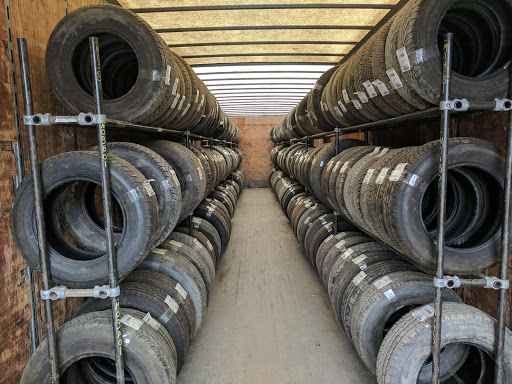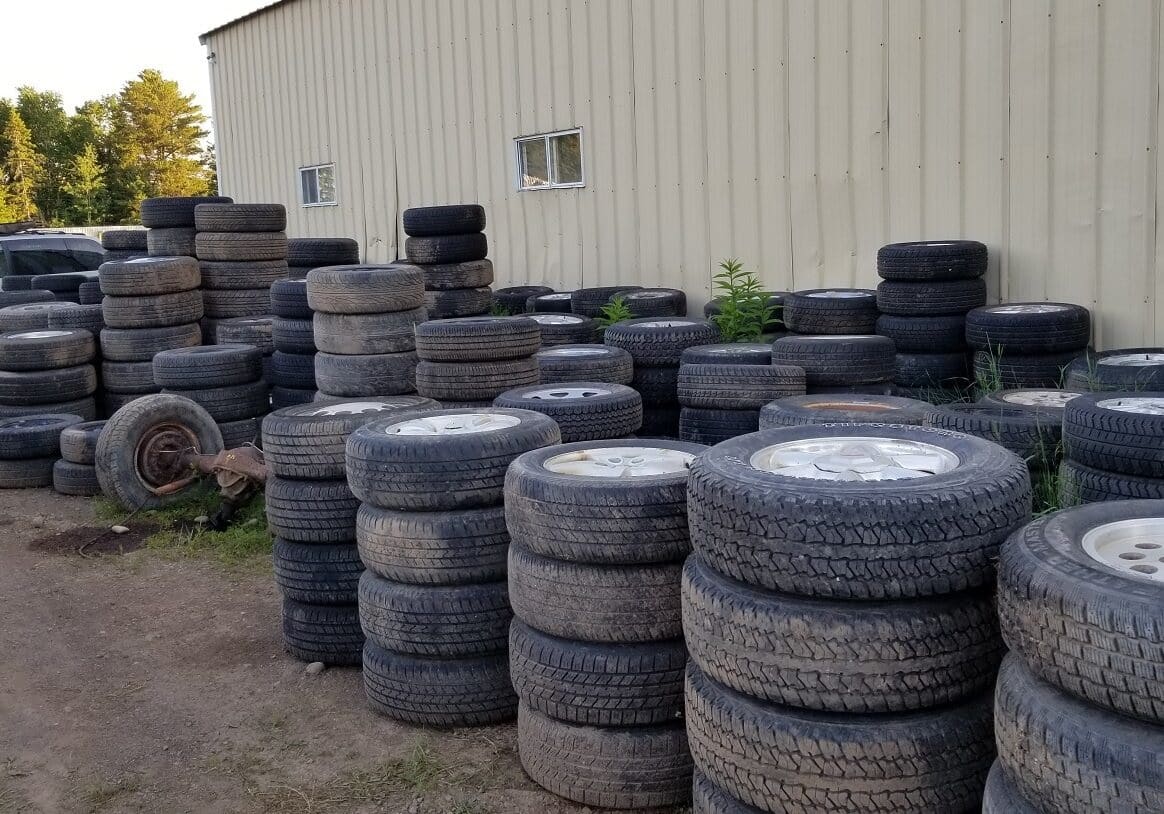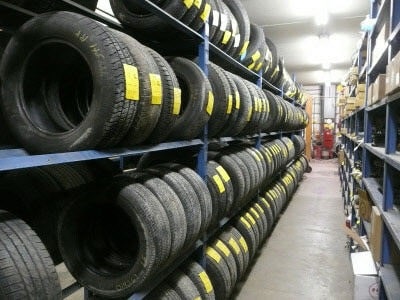The used tire business is about 30 million tires reused a year, which represents almost 10% of all tires in the US market. There are many places to get used tires for cheap. None however are as cheap as a used tire junkyard, where you can get more than 55% of the original retail price of the tire. Buying used tires however, isn’t for the faint of heart because you need to ensure they are safe to drive on. In this article I will show you where to find used tire junkyards near you, how the tire junkyards yards near me operate, and how to evaluate how much life is left in a tire.
Map of Tire Junkyards Near Me
For “Tire Junkyards Near Me” and “Tire Salvage Yards Near Me”, see the map below…
Who Sells Used Tires
Various places sell used tires. You can find them at junkyards, used tire shops, discount tire stores, re-treaders, and even online retailers. The cheapest deals you will find will be at your local salvage yards. The reason they are so cheap is they have been pulled of junked vehicles and junkyards aren’t solely reliant on their used tire sales. Also, they don’t spend the time to inspect the tires for safety or trying to meet a certain level of quality. Whatever comes in the yard goes in the tire pile for sale.
All of these businesses will vary in the type and quality of tires they sell. While I have found almost brand new tires at a junkyard, more often than not these tend to be lower in quality than other places that sell them.
That’s also due to the types and ages of vehicles coming into the scrap yard. It’s sometimes better to just buy used tires online than sifting through the piles of tires.
Operations of Used Tire Junkyards Yards Near Me
A tire salvage yard is just like any other business. They are locally owned and operated. While they are supposed to adhere to some government safety regulations, not all follow the rules and will sell you a bald tire.
These tire junkyards often don’t deal exclusively in tires, they often are used part salvage yards. They buy wrecked cars from private owners, insurance companies, and the police, and then sell them for parts. This is part of what makes the quality of tires so widely varying. You may find tires from a brand new vehicle in an accident and you may find rotted tires from a vehicle from the 80’s.
Some places strip the tires from the vehicles when they arrive and then put them in piles. These piles might be arranged by tire size, but more often are arranged by vehicle types such as car, truck, heavy duty truck, tractor, or motorcycle.
When you buy from them you can buy singles, pairs, or sets at heavily discounted prices. Single tires are easy to find, pairs are possible, and matched sets of four are very difficult. If you need a match set, you likely will have to mix brands and look for the same size, with similar treads and tread wear.

Junkyards that Buy Used Tires
Depending on what you have and how much money you are asking, you may find some salvos that will buy used tires from you. They tend to do this when the tires are in decent condition and they feel they can mark them up and sell them. If you have a set to sell, it’s worth giving your local auto parts salvage or tire salvage a call to negotiate. It is a good way to recycle your tires and get a few bucks toward a new pair.
Limited to No Government Regulation
It’s important to note that, unlike new tires, used tires at junkyards don’t have the same safety regulations and guarantees that the tire once had. The junkyard should NOT be selling you a bald tire, but just now some yards will.
Additionally, they don’t care if you buy the wrong size or the wrong weight bearing capacity. The salvage yard attendant isn’t a tire salesman at your local tire shop who will try and make sure you are putting the correct tire on your vehicle. They don’t care!
Since there aren’t many rules or laws to protect you when purchasing a tire from a junkyard, you must be armed with information. It is a buyer beware industry.
Choosing The Right Junkyard Tire
Without getting too crazy here, ultimately you want to buy the same size tire as the one you are replacing. This means the same size and rating with a particular focus on the load capacity. Never put a tire on your vehicle that doesn’t meet the minimum load requirements. If you are not sure what size tire meets your vehicle’s minimum requirements you can check the owner’s manual or the inside panel of your driver’s side door.
When facing a flat tire, selecting used car tires as the ideal replacement from auto salvage yards is crucial. Consider your budget and prioritize both quality and affordability when searching for cheap used tires. Look for trustworthy sources that offer a variety of quality used tires at affordable prices, ensuring a safe and cost-effective solution for your used car.

How to Inspect a Used Tire Before Purchasing It
Below is a basic guide to buying used tires at a junkyard. There is more advanced knowledge out there, but this should serve as a basic guideline on what to look for.
Tread Depth: This tells you how much life and wear are left in the tire. I like to look for 40 to 70% of the original tread depth. This is what I consider a good condition tire, that has a lot of mileage left in it. You can do a quick tread depth check with a penny. Flip the penny upside down and put it in each of the tread grooves. If Lincoln’s head is visible from any of the grooves, the tire is considered legally bald. If you want to know how much tread is left a general guide is car tires begin around 10/32 of an inch and truck tires vary, but begin around 12-14/32 of an inch.
Cord Exposure: Inspect the tread surface for metal chords (wires) sticking out. If you see any chords, even a few, this tire is unsafe for driving.
Belt Separation: Inspect the sidewall for bumps or waviness. This is caused by an impact to the tire which the sidewall delaminates for the belt. I like to run both my hands slowly over the tire’s sidewalls to feel for any irregularities. You can often feel them even in an uninflated tire.

Bead Chunking: Examine the tire bead, the two rubber rings that hug the wheel rim. Look for any rubber missing in the bead. This will create a problem when you try and install the tire. Bead chunking prevents the tire from sealing correctly.
Liner Damage: Examine the inside of the tire for liner damage or chord damage. Look for a “stripe” of wear around the inside sidewall that is soft to the touch or you may find “rubber dust” inside. If you find this then the tire is unsafe.
Improper Repairs: Look for improper or poorly done repairs like plugs and patches. Plugs in my opinion are always unsafe. A well-done patch is done on the inside of the tire and much safer. Avoid any plug or patch within an inch of either sidewall. I generally avoid plugged and patched tires all together,
Aging: Tires age from the inside out. Look for rotted rubber, which will look dry and fragile. Tires are supposed to have an identification number that has the creation date on them, but you will find many tire salvages illegally scratch them off. I never buy a tire that you suspect to be rotted or even a little old. As a rule, I don’t purchase used tires more than 6 years old.
Used Tires Pros and Cons

Getting used tires at a junkyard has its pros and cons. If you are savvy and know how to choose the right tires you will reap all of the benefits. If you are not you run all of the risks
The Benefits of Used Tire Junkyards
The key benefit to getting used tires at a local tire junk yard is that you will save $100’s from the original price. Saving is usually more than 55% and you can find tires in good condition with almost 70% of the tread left. Additionally, there will be a wide variety of brands, treads, and sizes to choose from.
In my opinion, a used tire is the way to go if you primarily drive locally, are only replacing one tire, or are at the end of a lease program for your vehicle.
The Downside of Salvaged Tires from Junkyards
The drawback to going used is safety and quality. Your tires ability to grip the road is the most important factor. These tires don’t need to adhere to safety regulations anymore for being sold. A tire junkyard will sell you an unsafe tire if you are willing to buy one.
Additionally, there will not be any guarantees on the tire and no salvage yards offer the ability to buy a warranty on used tires.
Tire Junkyards Near Me Conclusion
If you know what size tire you need and how to identify used tires in good condition a used tire junkyard is awesome. It’s important to spend time looking through a variety of tires in your size and load capacity range to ensure you are purchasing the best one available.
I also recommend never trusting a junkyard attendant to guide you toward the correct tires you need. In fact, I never buy used tires from anywhere I don’t inherently trust. That’s what I have learned from the used tire junkyards near me.
